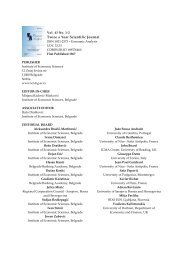Issue 16
Issue 16
Issue 16
You also want an ePaper? Increase the reach of your titles
YUMPU automatically turns print PDFs into web optimized ePapers that Google loves.
ERENET Profile Vol. IV, No. 4.<br />
www.erenet.org<br />
companies. This type of business is owned by the several big owners. Results were in the category of question<br />
concerned on the tangible property indicates no fundamental results between family and non-family business.<br />
Big differences are in the field of the software equipment. Family business is not equipped with the software<br />
application as is the non-family business. In all categories (MRP, CRM, SCM) of software modules were found<br />
reserves.<br />
Employees<br />
The other group of stakeholders was “Employees”. Most of observed companies were in the<br />
category with 100 -250 employees. Most of family business employs the less number of employees than nonfamily<br />
business.<br />
Graph 8: Number of employees<br />
Number of employees<br />
Source: Processed by author<br />
45,00%<br />
40,00%<br />
42,85%<br />
39,80%<br />
Non - family business<br />
Family business<br />
This can be caused by the 35,00% 32,96%<br />
fact that family companies are more 30,00%<br />
28,70%<br />
31,40%<br />
24,10%<br />
25,00%<br />
business (Doncles and Frohlich<br />
conservative than non-family<br />
1991, p. 149). In family firms we<br />
20,00%<br />
can also find the higher percentage<br />
15,00%<br />
of women. Same results are 10,00%<br />
presented by the research made in 5,00%<br />
USA. American business survey<br />
0,00%<br />
(2007) proved that 24% of family<br />
40-99 100-249 250 and more<br />
business is controlled by the<br />
woman. Within the past decade there has been an almost five-fold increase in the number of women leaders in<br />
family business since 1997 in USA 18 . This fact can cause the higher social responsibility in family business.<br />
This behavior can be also expressed by the higher ethical standards 19 . Family companies also spent much<br />
money on social benefits than non-family business. In family business we can find higher percentage of<br />
employees with university degrees. This characterizes family business. The PricewaterhouseCoopers (2007)<br />
research indicates that the priority investment is in human resources.<br />
Customers<br />
Another part of survey was dedicated to the group of “Customers” as stakeholders. The most<br />
common strategy within the family business is the differentiation strategy.<br />
Graph 9: Company strategy<br />
Source: Processed by author<br />
Family business is focused on the<br />
specific products with the<br />
possibility of higher prices in the<br />
combination with wide range of<br />
products and wide range of<br />
customers. Non- family business is<br />
orientated on the differentiation<br />
focus strategy. That means that<br />
non-family business is focused on<br />
35,00<br />
30,00<br />
25,00<br />
20,00<br />
15,00<br />
10,00<br />
5,00<br />
0,00<br />
COST LEADERSHIP<br />
Non family business Company strategy<br />
Family business<br />
31,25<br />
31,51<br />
28,42<br />
25,00<br />
22,60<br />
21,25<br />
22,50<br />
17,47<br />
DIFFERENTION<br />
COST FOCUS<br />
DIFFERENTIATION FOCUS<br />
18 American business survey. Mass mutual. Kenesaw State University. Family Firm Institute.2007.<br />
19 American business survey. Mass mutual. Kenesaw State University. Family Firm Institute.2007<br />
40
















